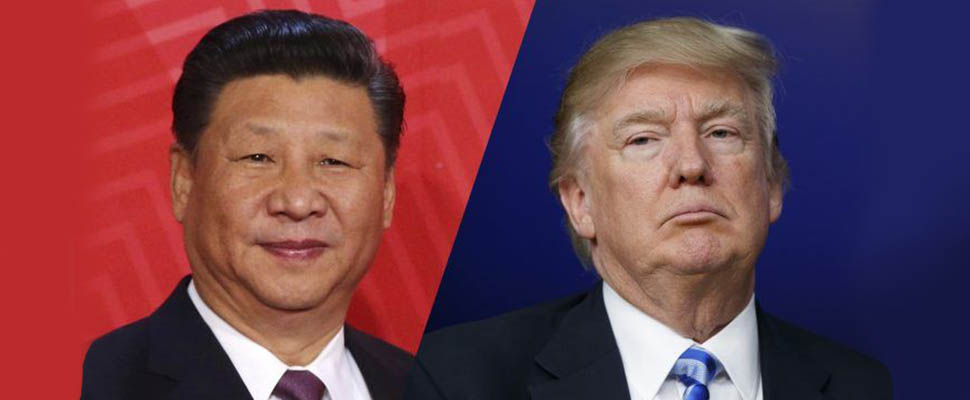3 keys to understanding the commercial tension between China and the US
Experts warn of a possible commercial war between the two giants of the world economy

Leer en español: 3 claves para entender la tensión comercial entre China y EE.UU
 Trump plays with fire by threatening to impose $ 100,000 million in taxes on China, in addition to the $ 50 billion in tariffs previously announced. This measure arose as a response to the "unjust reprisal by China", which announced tariffs of 25% on almost 250 US products such as soybeans, corn, beef, orange juice, tobacco, automobiles or certain types of aircraft, among others. , worth $ 50,000 million annually.
Trump plays with fire by threatening to impose $ 100,000 million in taxes on China, in addition to the $ 50 billion in tariffs previously announced. This measure arose as a response to the "unjust reprisal by China", which announced tariffs of 25% on almost 250 US products such as soybeans, corn, beef, orange juice, tobacco, automobiles or certain types of aircraft, among others. , worth $ 50,000 million annually.
The complex Sino-American trade relationship is one step away from the economic war, with reprisals from both sides imposing sanctions and tax burdens that place the relationship between the two countries at risk. But who started? Why does the United States attack China? How does it affect Latin America?
Here are three keys to understanding the trade tension between China and the United States that seems to generate more questions than answers.
How did it all begin?
The first economic blow came from the United States, when Chinese steel tariffs rose by 25% and aluminum by 10%, two of the main export products of the Asian power. In response to the first stone, China countered by fining 128 US products with tariffs, resulting in a price increase in the Chinese market for US products such as wine, pork, nuts and some fruits such as apples and oranges.
Followed by this, the United States announces a second wave of tariff measures that would cost Beijing $ 50 billion a year to Beijing, by imposing import tariffs on 1,300 Chinese products from the aerospace and high-tech sectors. Shortly thereafter, President Xi Jinping made a legal and official demand against the United States against the World Trade Organization (WTO), rebelling against the economic measures of the United States.
Trump did not back down. The tariffs that China imposed on the US gave rise to a new announcement. To the $ 50,000 million in tariffs previously announced, would add $ 100,000 million dollars in taxes to products related to intellectual property, although the US government has not specified what they are, will be linked to innovation and technology transfer.
Just a few hours later, China responded with the announcement to add 106 more US products to the tariff list, including soybeans, corn, beef, orange juice, tobacco, automobiles and certain types of aircraft.
Why does the United States attack China?
The Sino-American trade relationship has always been complicated, but since a year ago, the United States has a multimillion-dollar trade deficit with China between what it exports and what matters. Recall that last year, the United States imported approximately $ 505,000 million dollars, while only exported $ 130,000 to China, leaving a gap of $ 375,000 million dollars.
For Trump, this trade mismatch is due to the alleged theft of US technology and other illicit methods by China. The Office of the Foreign Trade Representative (USTR) determined that Beijing "has repeatedly participated in unfair practices to obtain intellectual property from the United States," Trump stressed.
How does it affect Latin America and the world?
Although Trump says these measures are designed to protect the US economy, experts say the spiral of tariffs will hit North American agricultural sectors.
China, on the other hand, has the option of buying soy from Latin American countries that produce large quantities of this food, such as Brazil and Argentina. In the same way, Australia produces many of the products that until now China bought from the United States, such as wine, grains or steel.
Both the United States and China are in an atmosphere of tension, while their political leaders could lead them to a possible economic war.
"We do not want a commercial war, but we are not afraid to wage one," the Chinese Ministry of Commerce said in a statement.
The Chinese ambassador to Washington, Cui Tiankai, also spoke out against Trump's measures. "Let me assure these people that they intend to fight a commercial war. We will certainly counterattack. We will retaliate. If people want to play rough, we will play rough with them and we will see who resists more, "he told the China Daily newspaper.
On the other hand, Trump is not entirely wrong, there have been investigations that indicate that China steals information of technological advances, in exchange for cheap labor, a deal that happens under the table and from which nobody had complained until now. The forecasts do not look very promising in the spiral of tariffs between China and the United States, a trade war between the two giants of the economy could unleash a true Pandora's box.
Latin American Post | María de los Ángeles Rubio
Translated from "3 claves para entender la tensión comercial entre China y EE.UU"





